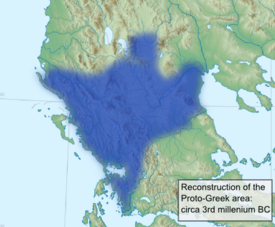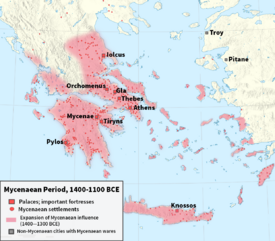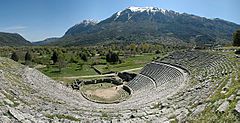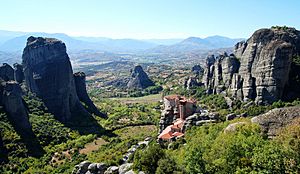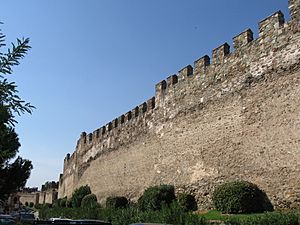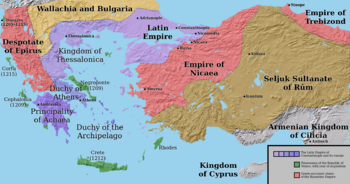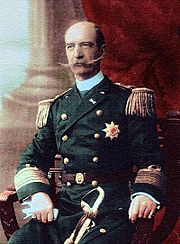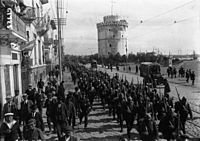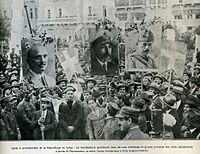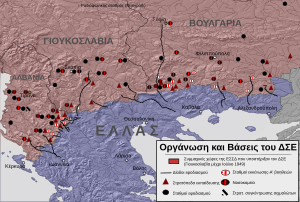History of Greece facts for kids
The history of Greece tells the story of the land we know as modern Greece. It also covers the history of the Greek people and the places they lived in and ruled over time. The areas where Greeks lived and ruled changed a lot through the ages. Because of this, the history of Greece includes many different times and places.
Generally, the history of Greece is split into these main periods:
- Paleolithic Greece: This period started about 3.3 million years ago and ended around 20,000 BC. Big changes in the land and climate happened in Greece. These changes were important for how plants and animals developed, and for how Homo sapiens survived in the area.
- Mesolithic Greece: This period lasted from 13,000 BC to about 7,000 BC. It was a time of slow growth for early human groups.
- Neolithic Greece: This began when farming societies started around 7,000 BC and ended about 3,200-3,100 BC. It was a key time for early Bronze Age civilizations in the area. The first organized communities grew, and basic art became more advanced.
- Bronze Age Greece: From about 3,200 BC to 1,100 BC, people started using metals more. This period saw the rise of the Cycladic culture in the Cyclades and the Minoan civilization around Crete. It ended with the rise and fall of the Mycenaean Greek palace culture.
- Ancient Greece: This usually includes Greek antiquity and some late prehistory. It lasted from about 1,200 BC to 600 AD. It can be divided into the Greek Dark Ages, Archaic period, Classical period, Hellenistic period, and Roman Greece.
- Byzantine Greece: This covers the time when Greece was part of the Byzantine Empire. It lasted from 324 AD until the fall of Constantinople in 1453.
- Frankish/Latin Greece: This period was from the Fourth Crusade in 1204 AD to 1797.
- Ottoman Greece: This covers the time of Ottoman rule from 1453 until the Greek Revolution of 1821.
- Modern Greece: This period starts from 1821 and continues to today.
At its biggest and most influential, Greek civilization reached from Egypt all the way to the Hindu Kush mountains in Afghanistan. Today, most Greeks live in the modern countries of Greece (which became independent in 1821) and Cyprus.
Contents
- Prehistoric Greece: The Earliest Times
- Ancient Greece: City-States and Great Thinkers (1,100–146 BC)
- Roman Greece: Culture Continues (146 BC – 324 AD)
- Middle Ages: Byzantine Empire and Beyond
- Venetian and Ottoman Rule (15th Century – 1821 AD)
- Modern Greece: Independence and Growth (1821 – Present)
- Modernization and City Growth
- Balkan Wars: Doubling Greece's Size
- World War I and the Greco-Turkish War
- Between Wars and World War II
- Greek Civil War: A Cold War Start (1944–1949)
- Postwar Development and Joining the West (1949–1967)
- Military Dictatorship (1967–1974)
- Third Hellenic Republic: Democracy Returns (1974 – Present)
- Greece in the Eurozone: Economic Challenges
- See also
Prehistoric Greece: The Earliest Times
When Did Humans First Live in Greece?
Scientists have found fossils of very early human-like creatures in Greece. One, called Ouranopithecus macedoniensis, lived about 9.6 to 8.7 million years ago. Another, Graecopithecus, might be the oldest direct ancestor of all humans, living 7.2 million years ago. Footprints found on the Greek island of Crete, 5.7 million years old, suggest that early human ancestors might have evolved outside of Africa. This is different from what many scientists believed before.
Life in the Paleolithic Period (About 3.3 Million BC – 13,000 BC)
The Paleolithic period in Greece is still being studied. However, new discoveries have been made recently. The oldest signs of humans in Greece were found at Petralona Cave in Chalkidiki. These date back 1 million years. At Apidima Cave in Mani, southern Greece, the oldest known remains of modern humans outside of Africa were found, dating to 210,000 years ago.
The Paleolithic period in Greece is divided into Lower (350,000–100,000 BP), Middle (100,000–35,000 BP), and Upper (35,000–11,000 BP). There are not many sites from the Lower Paleolithic. This is partly because of many earthquakes and changes in the Aegean Sea. These events destroyed many ancient living sites.
The Mesolithic Period (13,000–7,000 BC)
The Mesolithic period in Greece happened between the Upper Paleolithic and the Neolithic. Most Mesolithic sites in Greece are found near the coast. Important sites include Franchthi cave, Kalamakia cave in Mani, Asprochaliko cave in Epirus, and Theopetra. These places were lived in almost continuously during the Paleolithic and Mesolithic times.
From Neolithic Farming to the Bronze Age (7,000–1,100 BC)
The Neolithic Revolution, which brought farming, reached Europe around 7,000–6,500 BC. Farmers from the Near East came to Greece from Anatolia by traveling across the islands of the Aegean Sea. The earliest known farming sites in Europe were found in Greece. The first Greek-speaking tribes arrived in mainland Greece sometime in the Neolithic period or the Early Bronze Age (around 3,200 BC).
Cycladic and Minoan Civilizations: Early Island Cultures
The Cycladic culture was an important culture from the Late Neolithic and Early Bronze Age in the Cyclades islands. They are famous for their simple, flat female statues made from white marble.
The Minoan civilization in Crete was a Middle Bronze Age culture. It lasted from about 3,000 BC to 1,400 BC. We don't know much about the Minoans because their writing, Linear A and Cretan hieroglyphs, has not been figured out. Even the name Minoans is modern, coming from the legendary king Minos. They were mainly traders, doing a lot of business across the Mediterranean Sea.
Natural disasters like the volcanic eruption at Thera (around 1,628-1,627 BC) and earthquakes (around 1,600 BC) affected the Minoans. In 1,425 BC, most Minoan palaces were destroyed by fire. This allowed the Mycenaean Greeks, who were influenced by Minoan culture, to take over Crete.
Mycenaean Civilization: Warriors and Palaces
Mycenaean civilization grew from earlier cultures in mainland Greece. It started around 1,600 BC, influenced by Minoan Crete. It lasted until the Mycenaean palaces collapsed around 1,100 BC. Mycenaean Greece was the Late Helladic Bronze Age civilization. It is the historical setting for the epics of Homer and much of Greek mythology and religion. Important Mycenaean sites include Mycenae, Athens, Pylos, Thebes, and Tiryns.
Mycenaean society was led by warrior nobles. Around 1,400 BC, the Mycenaeans took control of Crete. They used a form of Minoan writing called Linear A to write an early form of Greek. This Mycenaean writing is called Linear B, and it was deciphered in 1952 by Michael Ventris. The Mycenaeans buried their nobles in large, circular tombs called tholoi. They often buried weapons and valuable items like gold masks with the dead.
Around 1,100–1,050 BC, the Mycenaean civilization fell apart. Many cities were attacked, and Greece entered a "dark age". During this time, the population decreased, and people lost the ability to read and write. Greeks traditionally blamed this on an invasion by another Greek group, the Dorians. However, there is not much archaeological proof for this idea.
Ancient Greece: City-States and Great Thinkers (1,100–146 BC)

Ancient Greece refers to a long period of Greek history. It usually starts around 1,000 BC, at the beginning of the Greek Dark Ages. It continues until the rise of the Roman Empire around 146 BC. Some historians also include the Minoan and Mycenaean civilizations, but others see them as separate.
Ancient Greece is often seen as the starting point for Western civilization. Greek culture had a huge impact on the Roman Empire, which then spread it across Europe. Ancient Greek civilization has influenced modern language, politics, education, philosophy, art, and architecture. This influence was especially strong during the Renaissance and later neo-classical periods.
The Iron Age: A Time of Change (1,100–800 BC)
The Greek Dark Ages (around 1,100–800 BC) was a period after the Mycenaean civilization collapsed. It lasted until the first Greek city-states appeared and writing returned. The fall of the Mycenaean civilization happened at the same time as other big empires in the Near East fell, like the Hittites and Egypt. The reason for this is still a mystery. Some believe it was due to invasions by groups called the Sea Peoples who used iron weapons.
During this period, iron replaced bronze for tools and weapons because it was cheaper and easier to find. Kings eventually lost power and were replaced by nobles. At the end of this quiet period, Greek civilization saw a rebirth. Writing was relearned from the Phoenicians, and this knowledge spread to other areas.
Archaic Greece: New Beginnings (800–480 BC)
In the 8th century BC, Greece started to recover from the Dark Ages. The ability to read and write had been lost, but Greeks adopted the Phoenician alphabet and created their own. Written records began to appear around the 9th century BC. Greece was divided into many small, self-governing communities. This was largely due to Greece's geography, with islands, valleys, and plains separated by sea or mountains.
This period is also known as the Orientalizing period. Greece was influenced by cultures from the East, like the Neo-Assyrian Empire. This influence can be seen in Greek art, religion, and myths.
Classical Greece: The Golden Age (490–323 BC)
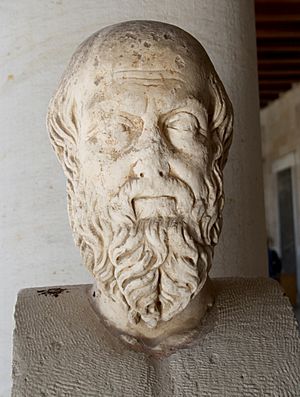
The main political unit in Ancient Greece was the polis, often called a "city-state". The word "politics" comes from polis. Each polis was usually independent. However, some were controlled by others. This meant that when Greece went to war, it was usually an alliance of city-states fighting together. It also led to many wars between different Greek city-states.
The Persian Wars: Defending Freedom
Two big wars shaped Classical Greece. The first was the Persian Wars (499–449 BC), described by the Greek historian Herodotus. By the late 6th century BC, the Persian Empire ruled over Greek cities in Ionia (modern-day Turkey). In 499 BC, these Greek cities revolted against Persia. Some mainland cities, like Athens and Eretria, supported them.
After the revolt was stopped, Darius I of Persia attacked mainland Greece for revenge. In 490 BC, his fleet landed at Marathon, but the Athenians won a big victory. Darius's successor, Xerxes I, launched a second invasion in 480 BC. Even though the Greeks lost at Thermopylae, they defeated the Persians at sea in the Battle of Salamis and on land at Plataea.
To fight Persia, Athens formed the Delian League in 477 BC. At first, cities contributed ships and soldiers. Later, Athens made smaller cities pay money instead, which strengthened Athens' control. The Delian League became known as the Athenian Empire.
The Peloponnesian War: Greeks Against Greeks
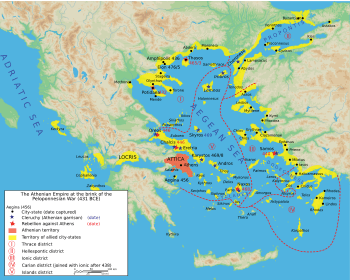
The Peloponnesian War (431–404 BC) was a major conflict between Athens and its allies (the Delian League) and Sparta and its allies (the Peloponnesian League). The main sources for this war are the historians Thucydides and Xenophon.
The war started in 431 BC over a dispute between Corcyra and Epidamnus. Corinth, a Spartan ally, got involved. Athens stepped in, fearing Corinth would take over Corcyra's navy. Sparta, worried about Athens' growing power, declared the treaty broken, and the war began.
The first part of the war lasted until 421 BC. Athens, led by Pericles, fought a defensive war, using its strong navy. However, a terrible plague hit Athens in 430 BC, killing many people, including Pericles. Later, Athens went on the attack. The war ended with the Peace of Nicias in 421 BC.
Peace lasted only seven years. The second part of the war began in 415 BC when Athens launched the Sicilian Expedition to conquer Sicily. This campaign was a disaster for Athens. After this defeat, Athens' allies in Ionia rebelled. The Spartan general Lysander built up Sparta's navy and won many victories. Athens finally surrendered in 404 BC, ending the Peloponnesian War. This led to a brief period where Sparta was the strongest power in Greece.
The war caused much damage. Discontent with Sparta's power led to the Corinthian War (395–387 BC). Athens, Thebes, Corinth, and Argos, supported by the Persian Empire, weakened Sparta. The war ended with a treaty where Sparta gave up Ionia and Cyprus to Persia. This led to more unrest. Thebans, led by Epaminondas, defeated Sparta at the Battle of Leuctra in 371 BC, starting a period of Theban power.
In 346 BC, Thebes asked Philip II of Macedon for help in a war. Macedon quickly united the Greek city-states under its control in the League of Corinth in 338–337 BC. In 336 BC, Philip's son, Alexander the Great, took power. He spent the next ten years conquering the Persian Empire, much of Western Asia, and Egypt. Alexander created one of the largest empires in history. After Alexander's death in 323 BC, his empire broke apart, starting the Hellenistic Age.
Hellenistic Greece: A Wider World (323–146 BC)
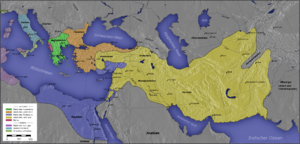
The Hellenistic period began with Alexander the Great's death in 323 BC. It ended when Rome conquered Greece in 146 BC. Even though Rome took over, Greek culture continued to thrive. During this time, the importance of mainland Greece decreased. The big centers of Greek culture became Alexandria in Egypt and Antioch in Syria.
After Alexander's death, his generals fought for power. This led to his empire splitting into several new kingdoms. Ptolemy got Egypt, and Seleucus got the Middle East. Control of Greece was fought over, but by 298 BC, the Antigonid dynasty ruled Macedon.
Macedon's control over the Greek city-states was not always strong, and there were many revolts. Athens, Rhodes, and Pergamum kept much of their independence. They joined the Aetolian League to protect themselves. The Achaean League also became independent and controlled much of southern Greece. Sparta remained independent but usually did not join any leagues.
In 267 BC, Ptolemy II convinced Greek cities to revolt against Macedon. This was called the Chremonidean War. The cities lost, and Athens lost its independence and democratic government. Athens remained an important cultural city, but not a political power.
Philip V of Macedon was the last Greek ruler who could have united Greece against Rome. In 215 BC, Philip allied with Rome's enemy, Carthage. Rome then turned Greek cities away from Philip and allied with Rhodes and Pergamum. The First Macedonian War (212–205 BC) ended without a clear winner, but Macedon was now Rome's enemy.
In 202 BC, Rome defeated Carthage and turned its attention to the East. The Second Macedonian War broke out in 198 BC. Philip's Greek allies left him, and he was defeated by Rome in 197 BC. Rome declared the Greek cities free, but this freedom was not real. Rome controlled a new League of cities and favored aristocratic governments.
Roman Greece: Culture Continues (146 BC – 324 AD)
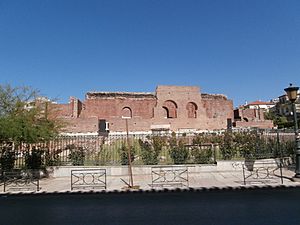
In the 2nd century BC, Greece was conquered by the Roman Republic. However, Greek culture continued to flourish. Greek city-states kept some self-rule. Roman society adopted many parts of Greek culture. For example, Roman poets like Ovid, Virgil, and Horace retold Greek myths. Roman society even claimed to be related to Greece, saying they came from the Trojan hero Aeneas.
Although Roman rule in Greece officially began with the sacking of Corinth in 146 BC, Macedonia had already come under Roman control in 168 BC. The Romans divided the region into four smaller republics. In 146 BC, Macedonia became a Roman province. The other Greek city-states eventually came under Rome's direct control. The Romans allowed Greeks to manage their local affairs. The agora in Athens remained the center of city life.
In 212 AD, Emperor Caracalla made all free adult men in the Roman Empire citizens. This made people in the provinces equal to those in Rome. This decree helped integrate societies like Greece more fully into the Roman Empire. It also helped set the stage for Greece, as part of the Eastern Roman Empire, to become a major power in Europe during the Middle Ages.
Middle Ages: Byzantine Empire and Beyond
Byzantine Rule: A New Roman Empire (324–1204 AD)
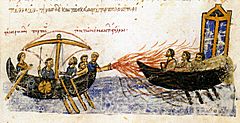
The Roman Empire split into East and West. The Western part eventually fell, but the Eastern part, known as the Byzantine Empire, continued. This made Greece more important within the empire. Constantinople (modern-day Istanbul) became the new capital of the Roman Empire in 324 AD, named by Constantine the Great. This change meant that Greek culture, or Hellenism, moved eastward towards Anatolia. Constantinople became a center for Greek culture for many centuries.
The early centuries of the Byzantine Empire (324–610 AD) saw emperors like Constantine the Great and Justinian trying to secure the empire's borders. They also worked to establish the Orthodox Church.
In the middle Byzantine era (610–867 AD), the empire faced attacks from old enemies like the Persians and new ones like the Arabs and Slavs. The empire was unstable, and enemies often reached deep into its lands.
Slavic attacks became less frequent as they settled and formed their own states. The Byzantines called these states Sclavinias. The empire's internal structure also changed. Greek culture and the Orthodox Church became very strong. The empire became more unified in language, religion, and culture.
From the late 8th century, the empire began to recover. The Greek peninsula was reconquered. Greeks from Sicily and Asia Minor were brought in to settle. Slavs were either moved or became part of Greek society. By the mid-9th century, Greece was back under Byzantine control. Its cities started to grow again due to better safety and central rule.
Economic Growth and Art in Byzantium
In the 12th century, Greece became very prosperous. The rural economy grew, with more people and new farmland. Many new churches were built in the countryside, showing that even remote areas were doing well.
Towns also grew significantly in the 12th century. Cities like Athens, Thessaloniki, Thebes, and Corinth experienced fast and steady growth. This growth attracted trade with the Venetian Republic from Italy. Venetians traded goods between the Crusader Kingdoms and the West, and also with Byzantium and Egypt.
A rebirth of Byzantine art began in the 10th century. Many important Byzantine churches in Greece were built around this time. This artistic revival showed the growth of cities. Mosaic art also saw a revival. Artists showed great interest in natural landscapes and animals. Mosaics became more realistic and colorful. Beautiful silks from Constantinople showed animals and emperors. This increased demand for art meant more people had enough money to pay for such works.
Byzantium was a major source of artistic inspiration for the West from the 10th to the 12th century. For example, the mosaics in St. Mark's Basilica in Venice show clear Byzantine influence. In Sicily, mosaics in places like the Palatine Chapel also show Byzantine art's impact. Even Romanesque art in Western Europe has many Byzantine elements.
The Fourth Crusade: A Turning Point (1204 AD)
The year 1204 marks the start of the Late Byzantine period. Latins from the Fourth Crusade conquered Constantinople and other Byzantine lands. Several Byzantine Greek states emerged, like the Empire of Nicaea and the Despotate of Epirus. They all claimed to be the true successors of the Byzantine Empire. Meanwhile, the Latin Crusaders founded the Catholic Latin Empire, with Constantinople as its capital. This period was known as Frankokratia or Latinokratia to the Byzantines. During this time, elements of feudalism entered Greek life.
Byzantine Restoration and Ottoman Arrival (1261–1453 AD)
The Latin Empire lasted only 57 years. In 1261, Constantinople was retaken by the Nicaean Empire, and the Byzantine Empire was restored. However, many Latin and Venetian lands remained in mainland Greece and the islands. From 1261 onwards, Byzantium slowly weakened due to Ottoman invasions. This ended with the fall of Constantinople on May 29, 1453. This event officially ended the Eastern Roman Empire and the Byzantine period of Greek history.
Venetian and Ottoman Rule (15th Century – 1821 AD)
The Greeks in the Peloponnese held out until 1460. The Venetians and Genoese kept some islands. But by the early 16th century, most of mainland Greece and the Aegean islands were taken over by the Ottoman empire. Only a few port cities remained under Venetian control. The Ionian Islands were never ruled by the Ottomans, except for a short time. They stayed under the rule of the Republic of Venice. It was in the Ionian Islands that modern Greek statehood began, with the creation of the Septinsular Republic in 1800.
When the Ottomans arrived, many Greeks moved. Some Greek thinkers went to Western Europe, helping to start the European Renaissance. Other Greeks left the plains and moved to the mountains.
Ottoman Greece was a society with many different groups. Greeks had some freedoms, but they also faced harsh rule from local officials. The Ottoman millet system helped Orthodox Greeks stay together by separating people based on religion. Greeks living in the plains were either Christians or crypto-Christians. Crypto-Christians were "Muslims" who secretly practiced Greek Orthodox faith. Some became crypto-Christians to avoid high taxes while keeping their religious identity. Greeks who converted to Islam were seen as "Turks" by Orthodox Greeks, even if they didn't speak Turkish. This shows the ethnic and religious tensions during Ottoman rule.
The Ottomans ruled most of Greece until the early 19th century. The first self-governing Greek state since the Middle Ages was the Septinsular Republic. It was established on the Ionian islands in 1800, 21 years before the Greek revolution in mainland Greece. Its capital was Corfu.
Modern Greece: Independence and Growth (1821 – Present)
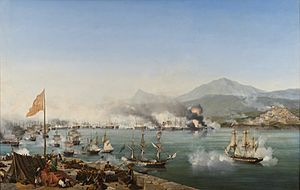
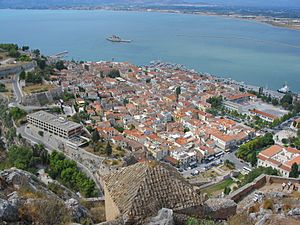
In early 1821, the Greeks declared their independence. However, they did not fully achieve it until 1829. Many non-Greeks, called philhellenes, volunteered to fight for Greece, including Lord Byron.
On October 20, 1827, British, French, and Russian naval forces destroyed the Ottoman and Egyptian fleet. Ioannis Kapodistrias, a Greek diplomat, became Governor of the First Republic. He helped secure Greek independence. The first capital was temporarily Aigina (1828–1829) and then officially Nafplion (1828–1834). After Kapodistrias was killed, European powers made Greece a monarchy. The first King, Otto, was from Bavaria, and the second, George I, was from Denmark. In 1834, King Otto moved the capital to Athens.
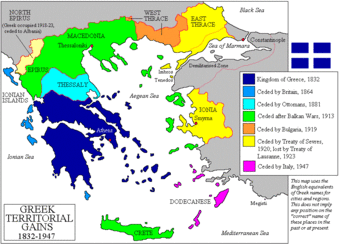
During the 19th and early 20th centuries, Greece tried to expand its borders to include more ethnic Greek people living in the Ottoman Empire. Greece played a small part in the Crimean War. Greek leaders saw a chance to expand into Ottoman areas with Christian majorities. However, Greece did not coordinate with Russia and did not declare war. Its efforts to cause revolts failed. The frustrated Greek leaders blamed the King, who was later forced to step down. Britain gave the Ionian Islands to Greece in 1863. Thessaly was given by the Ottomans in 1880.
Modernization and City Growth
In the late 19th century, Greece's society changed a lot due to modernization. The population grew quickly, putting pressure on small farms. Many people moved to the United States. Between 1906 and 1914, about 250,000 people left. Some sent money home, others returned with savings to buy farms or small businesses. The number of people living in cities tripled. Athens grew from a village of 6,000 in 1834 to 167,000 in 1907.
In cities, people from rural areas opened workshops and stores, creating a middle class. They joined with bankers, professionals, students, and military officers to demand reforms. Athens became a major center for shipping. As cities modernized, buildings adopted Western European styles.
Balkan Wars: Doubling Greece's Size
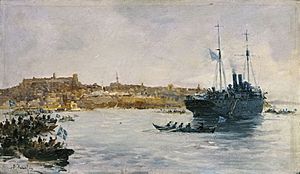
Greece's role in the Balkan Wars of 1912–1913 was very important. It allowed the Greek state to almost double its size. As a result, most of Epirus, Macedonia, Crete, and the northern Aegean islands became part of the Kingdom of Greece.
World War I and the Greco-Turkish War
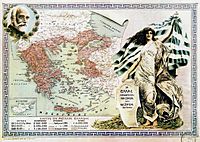

When World War I started in 1914, Greek politics split. King Constantine I wanted Greece to stay neutral. Prime Minister Eleftherios Venizelos wanted Greece to join the Allies. This conflict was called the National Schism. In 1917, the Allies forced Constantine to step down, and Venizelos returned as prime minister. After the war, the Great Powers agreed to give the Ottoman city of Smyrna (Izmir), which had many Greeks, to Greece.
Greek troops occupied Smyrna in 1919. In 1920, the Treaty of Sèvres was signed. It said that in five years, people in Smyrna would vote on whether to join Greece. However, Turkish nationalists, led by Mustafa Kemal Atatürk, overthrew the Ottoman government. They fought against the Greek troops in the Greco-Turkish War (1919–1922). A major Greek attack stopped in 1921, and by 1922, Greek troops were retreating. Turkish forces recaptured Smyrna on September 9, 1922. A fire then broke out in the city, causing many deaths among Armenians and Greeks.
The war ended with the Treaty of Lausanne (1923). This treaty led to a population exchange between Greece and Turkey based on religion. Over one million Orthodox Christians left Turkey, and 400,000 Muslims left Greece. The years 1914 to 1923 are seen as a very difficult time in Greek history. Many scholars believe that between 750,000 and 900,000 Greeks died during this period, which some call a genocide.
Between Wars and World War II


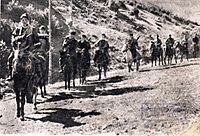
The Second Hellenic Republic was declared in 1924. It ended in 1935 when King George II of Greece returned. In August 1936, Prime Minister Metaxas, with the king's agreement, suspended parliament. He set up a strict government known as the Metaxas regime.
Despite its small army, Greece played an important role for the Allies in World War II. Greece sided with the Allies and refused Italy's demands. Italy invaded Greece in October 1940, but Greek troops fought back strongly. This was the first Allied victory in the war.
To protect his southern flank, German dictator Adolf Hitler invaded Greece in April 1941. German, Bulgarian, and Italian forces invaded Greece through Yugoslavia. They forced the Greek defenders to retreat. The Greek government decided to stop fighting and moved to Crete, then to Cairo, Egypt.
On May 20, 1941, the Germans tried to take Crete with a large paratrooper attack. They faced strong resistance. Some argue that the Greek campaign delayed Germany's invasion of the Soviet Union. The heavy losses of German paratroopers meant they launched no more large air invasions.
During the Axis occupation of Greece, thousands of Greeks died from fighting, in concentration camps, or from starvation. Most of the Jewish community was killed, despite efforts by Christian Greeks to help them. Greece's economy was ruined.
When the Soviet Army advanced in August 1944, the German Army in Greece began to withdraw. The German occupation of Greece ended in October 1944. The Resistance group ELAS took control of Athens on October 12, 1944. British troops arrived in Athens on October 14, 1944.
Greece suffered greatly during the war. Over 8% of its population died. About 2,000 villages and towns were destroyed. Starvation was widespread, and most of Greece's merchant ships were sunk.
Greek Civil War: A Cold War Start (1944–1949)
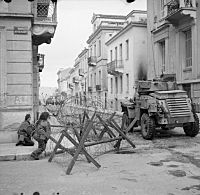
The Greek Civil War was the first major conflict of the Cold War. It was fought between 1944 and 1949. On one side were nationalist forces, supported by the United Kingdom and later the United States. On the other side was the Democratic Army of Greece (ELAS), the military part of the Communist Party of Greece (KKE).
The war ended with a victory for the government forces, supported by Britain and the U.S. Greece received American money through the Truman Doctrine and the Marshall Plan. It also became a member of NATO. This helped set the balance of power in the Aegean during the Cold War.
The first part of the civil war (1943–1944) saw Marxist and non-Marxist resistance groups fighting each other. In the second part (December 1944), the communists, who controlled most of Greece, faced the returning Greek government in exile. In the third part (1946–1949), KKE guerrilla forces fought against the recognized Greek government. The war was mainly fought in the mountains of northern Greece. It ended with NATO bombing and the defeat of the KKE forces. The civil war left Greece with strong political divisions. Greece allied with the United States and joined NATO. Its relations with communist neighbors became difficult.
Postwar Development and Joining the West (1949–1967)
In the 1950s and 1960s, Greece grew quickly. This was helped by money from the Marshall Plan, which also aimed to reduce communist influence. In 1952, Greece joined NATO, clearly becoming part of the Western side of the Cold War. However, deep divisions between left and right continued in Greek society.
The Greek economy grew further with the rise of tourism. More attention was given to women's rights. In 1952, women gained the right to vote. Lina Tsaldari became the first female minister.
The Greek economic miracle refers to the period of strong economic growth from 1950 to 1973. During this time, Greece's economy grew by an average of 7.7%, second only to Japan in the world.
Military Dictatorship (1967–1974)
In 1967, the Greek military took power in a coup d'état. They overthrew the government and set up the Greek military junta of 1967–1974, known as the Régime of the Colonels. This government isolated Greece from Europe and stopped its entry into the European Union. In 1973, the regime ended the Greek monarchy. In 1974, dictator Papadopoulos refused U.S. help. After another coup that year, Colonel Ioannides became the new leader.
Ioannides was responsible for the 1974 coup against President Makarios of Cyprus. This coup led to the first wave of the Turkish invasion of Cyprus in 1974. The events in Cyprus and protests after a violent crackdown on the Athens Polytechnic uprising led to the military regime's collapse.
Third Hellenic Republic: Democracy Returns (1974 – Present)
After the military regime ended, democracy was restored. This period is called the metapolitefsi. Konstantinos Karamanlis returned from exile in Paris and became interim prime minister in July 1974. He later won elections with his conservative New Democracy Party. In August 1974, Greek forces left NATO's military structure to protest the Turkish occupation of northern Cyprus.
In 1974, a vote decided to remove King Constantine II. A democratic republican constitution was put in place. Another politician, Andreas Papandreou, also returned and founded the socialist PASOK Party. PASOK won the 1981 election and was a major force in Greek politics for almost two decades.

After democracy returned, Greece became much more stable and economically successful. Greece rejoined NATO in 1980. It joined the European Union (EU) in 1981 and started using the euro currency in 2001. New money from the EU and growing income from tourism, shipping, and other industries have given Greeks a much better standard of living. Tensions still exist between Greece and Turkey over Cyprus and borders in the Aegean Sea. However, relations have improved after earthquakes in both countries led to help and sympathy from ordinary Greeks and Turks.
Greece in the Eurozone: Economic Challenges
The 2008 global economic downturn affected Greece, like other countries in the eurozone. From late 2009, people worried about Greece's ability to pay its debts because of its large government debt. This led to a sovereign debt crisis. On May 2, 2010, Eurozone countries and the International Monetary Fund agreed to a €110 billion loan for Greece. This loan came with strict conditions for cutting government spending.
In October 2011, Eurozone leaders agreed to write off 50% of Greece's debt owed to private lenders. These spending cuts were very unpopular with the Greek public, leading to protests and unrest. This period, known as the Greek government-debt crisis, changed the political scene. The radical party SYRIZA became the largest party on the left.
Alexis Tsipras led SYRIZA to victory in the general election on January 25, 2015. He formed a coalition government. Tsipras called new elections in August 2015. In the September 2015 election, SYRIZA won again. However, he was defeated in the July 2019 election by Kyriakos Mitsotakis of the New Democracy party. On July 7, 2019, Kyriakos Mitsotakis became the new Prime Minister of Greece.
In March 2020, Greece's parliament elected Katerina Sakellaropoulou as the first female President of Greece.
|
See also
 In Spanish: Historia de Grecia para niños
In Spanish: Historia de Grecia para niños
- History of Crete
- History of Cyprus
- History of Athens
- History of Macedonia
- History of the Greek language
- Timeline of Ancient Greece
- Timeline of modern Greek history
- Neolithic Greece
- Aegean civilization
- Minoan civilization
- Mycenaean Greece
- Greek Dark Ages


